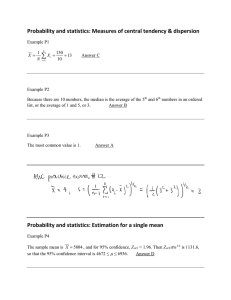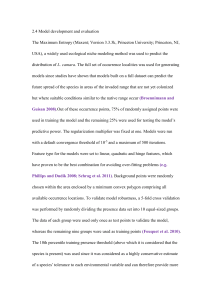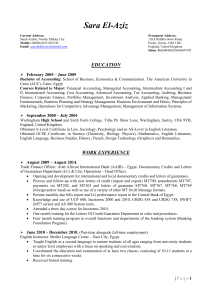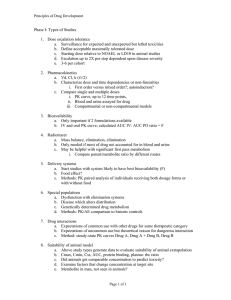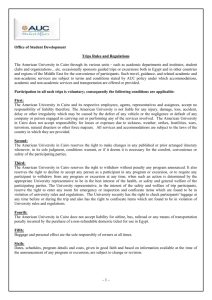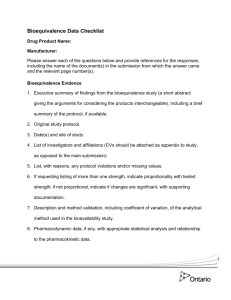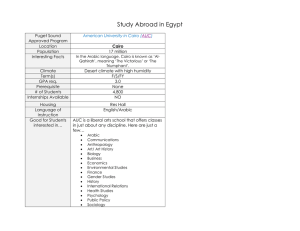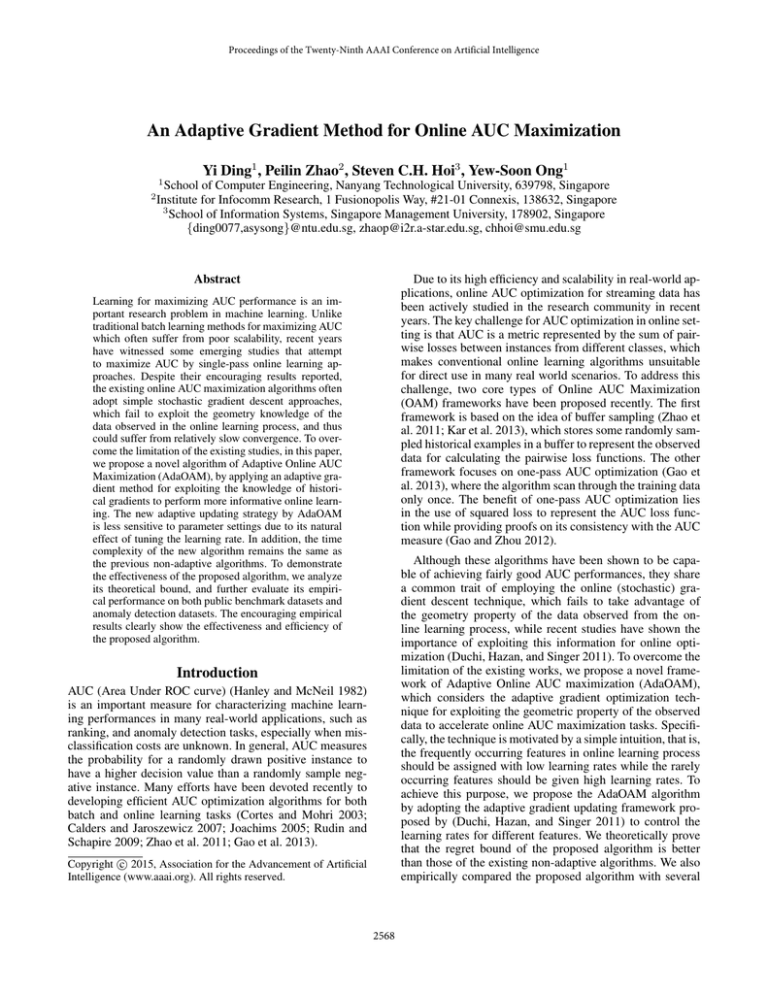
Proceedings of the Twenty-Ninth AAAI Conference on Artificial Intelligence
An Adaptive Gradient Method for Online AUC Maximization
1
2
Yi Ding1 , Peilin Zhao2 , Steven C.H. Hoi3 , Yew-Soon Ong1
School of Computer Engineering, Nanyang Technological University, 639798, Singapore
Institute for Infocomm Research, 1 Fusionopolis Way, #21-01 Connexis, 138632, Singapore
3
School of Information Systems, Singapore Management University, 178902, Singapore
{ding0077,asysong}@ntu.edu.sg, zhaop@i2r.a-star.edu.sg, chhoi@smu.edu.sg
Due to its high efficiency and scalability in real-world applications, online AUC optimization for streaming data has
been actively studied in the research community in recent
years. The key challenge for AUC optimization in online setting is that AUC is a metric represented by the sum of pairwise losses between instances from different classes, which
makes conventional online learning algorithms unsuitable
for direct use in many real world scenarios. To address this
challenge, two core types of Online AUC Maximization
(OAM) frameworks have been proposed recently. The first
framework is based on the idea of buffer sampling (Zhao et
al. 2011; Kar et al. 2013), which stores some randomly sampled historical examples in a buffer to represent the observed
data for calculating the pairwise loss functions. The other
framework focuses on one-pass AUC optimization (Gao et
al. 2013), where the algorithm scan through the training data
only once. The benefit of one-pass AUC optimization lies
in the use of squared loss to represent the AUC loss function while providing proofs on its consistency with the AUC
measure (Gao and Zhou 2012).
Abstract
Learning for maximizing AUC performance is an important research problem in machine learning. Unlike
traditional batch learning methods for maximizing AUC
which often suffer from poor scalability, recent years
have witnessed some emerging studies that attempt
to maximize AUC by single-pass online learning approaches. Despite their encouraging results reported,
the existing online AUC maximization algorithms often
adopt simple stochastic gradient descent approaches,
which fail to exploit the geometry knowledge of the
data observed in the online learning process, and thus
could suffer from relatively slow convergence. To overcome the limitation of the existing studies, in this paper,
we propose a novel algorithm of Adaptive Online AUC
Maximization (AdaOAM), by applying an adaptive gradient method for exploiting the knowledge of historical gradients to perform more informative online learning. The new adaptive updating strategy by AdaOAM
is less sensitive to parameter settings due to its natural
effect of tuning the learning rate. In addition, the time
complexity of the new algorithm remains the same as
the previous non-adaptive algorithms. To demonstrate
the effectiveness of the proposed algorithm, we analyze
its theoretical bound, and further evaluate its empirical performance on both public benchmark datasets and
anomaly detection datasets. The encouraging empirical
results clearly show the effectiveness and efficiency of
the proposed algorithm.
Although these algorithms have been shown to be capable of achieving fairly good AUC performances, they share
a common trait of employing the online (stochastic) gradient descent technique, which fails to take advantage of
the geometry property of the data observed from the online learning process, while recent studies have shown the
importance of exploiting this information for online optimization (Duchi, Hazan, and Singer 2011). To overcome the
limitation of the existing works, we propose a novel framework of Adaptive Online AUC maximization (AdaOAM),
which considers the adaptive gradient optimization technique for exploiting the geometric property of the observed
data to accelerate online AUC maximization tasks. Specifically, the technique is motivated by a simple intuition, that is,
the frequently occurring features in online learning process
should be assigned with low learning rates while the rarely
occurring features should be given high learning rates. To
achieve this purpose, we propose the AdaOAM algorithm
by adopting the adaptive gradient updating framework proposed by (Duchi, Hazan, and Singer 2011) to control the
learning rates for different features. We theoretically prove
that the regret bound of the proposed algorithm is better
than those of the existing non-adaptive algorithms. We also
empirically compared the proposed algorithm with several
Introduction
AUC (Area Under ROC curve) (Hanley and McNeil 1982)
is an important measure for characterizing machine learning performances in many real-world applications, such as
ranking, and anomaly detection tasks, especially when misclassification costs are unknown. In general, AUC measures
the probability for a randomly drawn positive instance to
have a higher decision value than a randomly sample negative instance. Many efforts have been devoted recently to
developing efficient AUC optimization algorithms for both
batch and online learning tasks (Cortes and Mohri 2003;
Calders and Jaroszewicz 2007; Joachims 2005; Rudin and
Schapire 2009; Zhao et al. 2011; Gao et al. 2013).
c 2015, Association for the Advancement of Artificial
Copyright Intelligence (www.aaai.org). All rights reserved.
2568
state-of-the-art online AUC optimization algorithms on both
benchmark datasets and real-world online anomaly detection datasets. The promising results further validate the effectiveness and efficiency of the proposed algorithm.
The rest of this paper is organized as follows. We first
review related works from both online learning and AUC
optimization, and then present the formulations of the proposed approach and its theoretical analysis; we further discuss our obtained experimental results, and the sensitivity of
the parameters, and finally conclude the paper with a brief
summary of our work.
learning algorithms for AUC optimization involving largescale applications. Among the online AUC optimization approaches, two core online AUC optimization frameworks
have been proposed very recently. The first framework is
based on the idea of buffer sampling (Zhao et al. 2011;
Kar et al. 2013), which employed a fixed-size buffer to represent the observed data for calculating the pairwise loss
functions. A representative study is available in (Zhao et
al. 2011), which leveraged the reservoir sampling technique
to represent the observed data instances by a fixed-size
buffer where notable theoretical and empirical results have
been reported. Then, (Kar et al. 2013) studied the improved
generalization capability of online learning algorithms for
pairwise loss functions with the framework of buffer sampling. The main contribution of their work is the introduction of the stream subsampling with replacement as the
buffer update strategy. The other framework which takes a
different perspective was presented by (Gao et al. 2013).
They extended the previous online AUC optimization framework with a regression-based one-pass learning mode, and
achieved solid regret bounds by considering square loss for
the AUC optimization task due to its theoretical consistency
with AUC.
Despite the extensive works in both the fields of online
learning and AUC optimization, to the best of our knowledge, our current work represents a first effort to explore
adaptive gradient optimization and second order learning
techniques for online AUC optimization. In particular, we
explore the second order statistics of data to update the classifier adaptively at each stage and take full advantage of the
geometrical information available in the data.
Related Work
Our work is closely related to two topics in the context of
machine learning, namely, online learning and AUC optimization. Below we briefly review some of the important
related works in both areas.
Online Learning. Online learning has been extensively
studied in the machine learning communities (Cesa-Bianchi
and Lugosi 2006; Crammer et al. 2006; Zhao, Hoi, and Jin
2011; Hoi et al. 2013; Zhao et al. 2014), mainly due to its
high efficiency and scalability to large-scale datasets. Differing from conventional batch learning methods that assume all training instances are available prior to the learning phase, online learning considers one instance each time
to update the model sequentially and iteratively. Therefore,
online learning is ideally appropriate for tasks in which data
arrives sequentially. A number of first-order algorithms have
been proposed including the well-known Perceptron algorithm (Rosenblatt 1958) and the Passive-Aggressive (PA)
algorithm (Crammer et al. 2006). Although the PA introduces the concept of “maximum margin” for classification,
it fails to control the direction and scale of parameter updates during online learning phase. In order to address this
issue, recent years have witnessed some second-order online
learning algorithms (Dredze, Crammer, and Pereira 2008;
Crammer, Kulesza, and Dredze 2009; Orabona and Crammer 2010; Wang, Zhao, and Hoi 2012), which apply parameter confidence information to improve online learning
performance. Further, in order to solve the cost-sensitive
classification tasks on-the-fly, online learning researchers
have also proposed a few novel online learning algorithms
to directly optimize some more meaningful cost-sensitive
metrics (Wang, Zhao, and Hoi 2014; Zhao and Hoi 2013;
Hoi and Zhao 2013).
AUC Optimization. AUC (Area Under ROC curve) is an
important performance measure that has been widely used in
imbalanced data distribution classification. The ROC curve
explains the rate of the true positive against the false positive at various range of threshold. Thus, AUC represents
the probability that a classifier will rank a randomly chosen positive instance higher than a randomly chosen negative one. Recently, many algorithms have been developed
to optimize AUC directly (Cortes and Mohri 2003; Calders
and Jaroszewicz 2007; Joachims 2005; Zhao et al. 2011;
Gao et al. 2013). In (Joachims 2005), the author firstly
presented a general framework for optimizing multivariate
nonlinear performance measures such as the AUC, F1, etc.
in a batch mode. However, it is worth investigating online
An Adaptive Gradient Method for OAM
Problem Setting
We aim to learn a linear classification model that maximizes
AUC for a binary classification problem. Without loss of
generality, we assume positive class to be less than negative
class. Denote (xt , yt ) as the training instance received at the
t-th trial, where xt ∈ Rd and yt ∈ {−1, +1}, and wt ∈ Rd
is the weight vector learned so far.
Given this setting, let us define the AUC measurement (Hanley and McNeil 1982) for binary classification task. Given a dataset D = {(xi , yi ) ∈ Rd ×
{−1, +1}| i ∈ [n]}, where [n] = {1, 2, . . . , n}, we divide it into two sets naturally: the set of positive instances
D+ = {(x+
i , +1)| i ∈ [n+ ]} and the set of negative instances D− = {(x−
j , −1)| j ∈ [n− ]}, where n+ and n− are
the numbers of positive and negative instances, respectively.
For a linear classifier w ∈ Rd , its AUC measurement on D
is defined as follows:
n+ n−
AUC(w) =
i=1
j=1 I(w·x+ >w·x− )
i
j
+ 21 I(w·x+ =w·x− )
i
n+ n−
j
,
where Iπ is the indicator function that outputs a 1 if the prediction
π holds and 0 otherwise. We replace the indicator function with
the following convex surrogate, i.e., the square loss from (Gao et
al. 2013) due to its consistency with AUC (Gao and Zhou 2012)
−
+
− 2
(w, x+
i − xj ) = (1 − w · (xi − xj )) ,
2569
Algorithm 1 The AdaOAM Algorithm
Input: The regularization parameter λ, the learning rate
{ηt }Tt=1 , δ ≥ 0 for AGU update.
−
+
−
Initialize w0 = 0, c+
0 = c0 = 0, T0 = T0 = 0,
−
Γ+
0 = Γ0 = [0]d×d .
for t = 1, 2, . . . , T do
Receive an incoming instance (xt , yt );
if yt = +1 then
+
−
+ 1, Tt− = Tt−1
;
Tt+ = Tt−1
+
+
−
−
1
c+
t = ct−1 + T + (xt − ct−1 ) and ct = ct−1 ;
and find the optimal classifier by minimizing the following objective function
n+ n−
−
(w, x+
i − xj )
λ
i=1
j=1
2
.
(1)
L(w) = w2 +
2
2n+ n−
where λ2 w22 is introduced to regularize the complexity of
the√linear classifier. Note, the optimal w∗ satisfies w∗ 2 ≤
1/ λ according to the strong duality theorem.
Adaptive Online AUC Maximization
t
−
−
Update Γ+
t and Γt = Γt−1 ;
ĝt updated by AGU;
else
−
+
+ 1, Tt+ = Tt−1
;
Tt− = Tt−1
−
−
−
+
1
ct = ct−1 + T − (xt − ct−1 ) and c+
t = ct−1 ;
Now, we are ready to introduce the proposed Adaptive Online AUC Maximization (AdaOAM) algorithm. Following
the similar approach in (Gao et al. 2013), we modify the
loss function L(w) in (1) as a sum of losses for individual
T
Lt (w) where
training instance
t
+
+
Update Γ−
t and Γt = Γt−1 ;
ĝt updated by AGU;
end if
wt = Π √1 (wt−1 − ηt ĝt );
λ
end for
t=1
t−1
I[ yi = yt ](1 − yt (xt − xi ) w)2
λ
i=1
2
Lt (w) = w2 +
,
2
2|i ∈ [t − 1] : yi yt = −1|
for i.i.d. sequence St = {(xi , yi )|i ∈ [t]}, and it is an unbiased estimation to L(w). Xt+ and Xt− are denoted as the sets
of positive and negative instances of St respectively, and Tt+
and Tt− are their respective cardinalities. Besides, Lt (w) is
set as 0 for Tt+ Tt− = 0. If yt = 1, the gradient is
∇Lt (w)
= λw +
xt x
t w
Using c−
t =
1
Tt−
− xt +
i:yi =−1
i:yi =−1
Adaptive Gradient Updating
In order to perform feature-wise gradient updating, we
employ the second order gradient optimization technique,
i.e., Adaptive Gradient Updating (AGU) strategy, inspired
by (Duchi, Hazan, and Singer 2011), which is detailed in
the following Algorithm 2.
xi+ (xi x
i −xi xt −xt xi )w
.
Tt−
xi and St− =
1
Tt−
i:yi =−1
(xi x
i −
Algorithm 2 Adaptive Gradient Updating (AGU)
Input: δ ≥ 0.
Output: Adjusted gradient ĝt .
Variables: s ∈ Rd , H ∈ Rd×d , g1:t,i ∈ Rt for i ∈
1, . . . , d.
Initialize g1:0 = [ ].
for t = 1, 2, . . . , T do
Suffer loss Lt (w);
Receive gradient gt = ∇Lt (w);
Update g1:t = [g1:t−1 gt ], st,i = g1:t,i 2 ;
Ht = δI + diag(st );
ĝt = Ht−1 gt ;
end for
Return ĝt
− c−
t [ct ] ) refer to the mean and covariance matrix of negative class, respectively, the gradient can be simplified as
−
− −
∇Lt (w) =λw− xt + c−
t + (xt − ct )(xt − ct ) w+ St w.
Similarly, if yt = −1,
+
+ +
∇Lt (w) =λw+ xt − c+
t + (xt − ct )(xt − ct ) w+ St w,
where c+
t =
1
Tt+
i:yi =1
xi and St+ =
1
Tt+
i:yi =1
(xi x
i −
+ c+
t [ct ] ) are the mean and covariance matrix of positive
class, respectively.
√
Upon obtaining gradient ∇Lt (w), due to w∗ ≤ 1/ λ,
the model can be updated with wt = Π √1 (wt−1 −
√
λ
λ
ηt ĝt (wt−1 )), where Π √1 (w) = min(1, 1/
w2 )w, ηt is the
λ
learning rate for the t-th iteration, ĝt is the adaptive gradient calculated using the Adaptive Gradient Updating (AGU)
strategy, which will be detailed in the next subsection.
Finally, Algorithm 1 summarizes the proposed AdaOAM
+
−
−
method. If setting Γ+
t = St and Γt = St , the covariance
matrices are updated as follows:
+
+
−
−
+
+
+
+ Γt = Γt−1+ct−1 [ct−1 ] −ct [ct ] +
−
−
−
− +
+
+
xt x
t − Γt−1− ct−1 [ct−1 ]
Γt = Γt−1+ ct−1 [ct−1 ] − ct [ct ] +
Tt+
−
−
−
xt x
t −Γt−1−ct−1 [ct−1 ]
Tt−
The intuition of this strategy is very natural, which considers the rare occurring features as more informative and discriminative than those frequently occurring features. Thus,
these informative rare occurring features should be updated
with higher learning rates by incorporating the geometrical
property of the data observed in earlier stages. Besides, by
using the previously observed gradients, the update process
can mitigate the effects of noise and speed up the convergence rate intuitively. In order to reduce the computation efforts incurred, we adopted the roots of the diagonal matrices
(approximation to the Hessian of the loss functions). Further, the smooth parameter δ > 0 is introduced to make the
,
.
2570
where C ≤ (1 + √2λ )2 is a constant to bound the
scalar of the second term of the right side, and rt,i =
maxj<t |xj,i − xt,i |, we have
diagonal matrix invertible and the algorithm robust, which
is usually set as a very small value.
Theoretical Analysis
d
This section presents our main theoretical results. First, we
give the regret bound of the proposed AdaOAM algorithm.
√
Theorem 1. Assume wt ≤ 1/ λ, (∀t ∈ [T ]) and
the diameter of χ = {w|w ≤ √1λ } is bounded via
supw,u∈χ w − u∞ ≤ D∞ , we have
where C ≤ (1 +
√2 )2 ,
λ
w
t
t=1
Lt (w).
λ
Concretely, for some small fixed δ ≥ 0, we set Ht = δI +
diag(st ) and ψt (gt ) = gt , Ht gt . We also denote the dual
norm of · ψt by · ψt∗ , in which case gt ψt∗ = gt H −1 .
t
From (Duchi, Hazan, and Singer 2011), it is known that
t=1
≤2
d
In this section, we evaluate the proposed AdaOAM algorithm in terms of AUC performance, convergence rate, and
examine its parameter sensitivity. The framework of experiments is based on the open-source library for large-scale
online learning LIBOL 1 (Hoi, Wang, and Zhao 2014).
g1:T,i 2 .
i=1
Comparison Algorithms
We compare the proposed algorithm with other state-of-theart online AUC optimization algorithms. Specifically, the algorithms considered in our empirical studies include:
wt+1 = arg min {η
gt , w + ηϕ(w) + Bψt (w, wt )},
• OAMseq : the OAM algorithm with reservoir sampling and
sequential updating method (Zhao et al. 2011);
• OAMgra : the OAM algorithm with reservoir sampling and
online gradient updating method (Zhao et al. 2011);
• OPAUC: the one-pass AUC optimization algorithm proposed in (Gao et al. 2013);
• AdaOAM: the proposed adaptive gradient approach for
online AUC maximization.
w≤ √1
λ
where Bψt (w, wt ) is the Bregman divergence associated
with a strongly convex and differentiable function ψt . In our
case, the regularization function ϕ ≡ 0. Thus, we have a
regret bound of
[Lt (wt ) − Lt (w∗ )] ≤
t=1
√
2D∞
d
g1:T,i 2 ,
i=1
Experimental Testbed and Setup
where χ = {w|w ≤ √1λ } is bounded via supw,u∈χ w −
u∞ ≤ D∞ . Next, we would like to analyze the features’
dependency on the data of the gradient. Since
2
(gt,i ) ≤ λwt,i +
t−1
t=1
Experimental Results
In addition, we consider the composite mirror descent
method to update the gradient in our case. So we arrive at
T
i=1
From the proof above, we can conclude that Algorithm 2
should have a lower regret than non-adaptive algorithms due
to its dependence on the geometry of the underlying data
space. If the features have been normalized and sparse, the
d
g1:T,i 2 should be much
gradient terms in the bound
i=1
√
smaller than T , which leads to lower regret and faster convergence. If the feature space√is relative dense, then the convergence rate will be O(1/ T ) for the general case as in
OPAUC and OAM methods.
wt+1 = Π √1 (wt − ηHt−1 gt ).
gt 2ψt∗
t=1
T
T
d [Lt (wt ) − Lt (w∗ )] ≤ 2D∞
[(λwt,i )2 + C(rt,i )2 ].
Based on the regularizer λ2 w2 , it is easy to obtain
w∗ 2 ≤ 1/λ due to the strong convexity property, and it
is also reasonable to restrict wt by wt 2 ≤ 1/λ. Denote
the projection of a point w onto u2 ≤ √1λ according to
L2-norm by Π √1 (w) = arg minu≤ √1 u − w2 . After
λ
λ
introducing the above, our adaptive subgradient descent employs the following update:
T
d T
√ [(λwt,i )2 + C(rt,i )2 ].
2
Finally, combining the above inequalities, we arrive at
and rt,i = maxj<t |xj,i − xt,i |.
Proof. We first define w∗ as w∗ = arg min
t=1
i=1
i=1
t=1
i=1
=
≤
T
T
d [Lt (wt ) − Lt (w∗ )] ≤ 2D∞
[(λwt,i )2 + C(rt,i )2 ],
t=1
g1:T,i 2
i=1
d T
(gt,i )2
(1 − yt xt − xj , w)yt (xj,i − xt,i ) j=1
To examine the performances of the proposed AdaOAM
in comparison to existing state-of-the-art methods, we conduct extensive experiments on various benchmark datasets
by maintaining consistency to the previous studies on online AUC maximization (Zhao et al. 2011; Gao et al. 2013).
Table 1 shows the details of 6 binary-class datasets in our
2
Tt−
≤ 2(λwt,i )2 + 2C(xj,i − xt,i )2 = 2(λwt,i )2 + 2C(rt,i )2 ,
1
2571
http://libol.stevenhoi.org/
Table 1: Details of benchmark machine learning datasets.
Dataset
german
svmguide3
vehicle
acoustic
svmguide4
w1a
# instances
1,000
1,243
846
78,823
300
2,477
# dimensions
24
22
18
50
10
300
Table 3: Details of anomaly detection datasets.
T− /T+
2.3333
3.1993
3.2513
3.3165
5.8181
33.4028
Dataset
webspam
cod-rna
smartBuilding
malware
# instances
350,000
271,617
20,000
71,709
# dimensions
254
8
14
122
T− /T+
1.5397
2.0000
85.2069
188.7063
Table 4: Evaluation on anomaly detection datasets.
Algorithm
Table 2: Evaluation on benchmark datasets.
Algorithm
OAMseq
OAMgra
OPAUC
AdaOAM
Algorithm
OAMseq
OAMgra
OPAUC
AdaOAM
Algorithm
OAMseq
OAMgra
OPAUC
AdaOAM
german
svmguide3
AUC
Time(s)
AUC
Time(s)
0.7333 ± 0.0367
0.7208 ± 0.0361
0.7263 ± 0.0683
0.7719 ± 0.0371
0.9610
0.9777
0.0201
0.0430
0.7001 ± 0.0444
0.6969 ± 0.0471
0.7205 ± 0.0376
0.7358 ± 0.0366
1.2152
1.1969
0.0242
0.0500
vehicle
OAMseq
OAMgra
OPAUC
AdaOAM
Algorithm
OAMseq
OAMgra
OPAUC
AdaOAM
acoustic
AUC
Time(s)
AUC
Time(s)
0.7760 ± 0.0446
0.7531 ± 0.0468
0.7597 ± 0.0311
0.7968 ± 0.0274
0.8202
0.7966
0.0138
0.0325
0.8665 ± 0.0148
0.8675 ± 0.0109
0.8881 ± 0.0022
0.8949 ± 0.0020
77.2125
77.7828
3.5908
5.4712
AUC
Time(s)
AUC
Time(s)
0.7829 ± 0.0519
0.7619 ± 0.0876
0.7404 ± 0.0779
0.8190 ± 0.0894
0.2755
0.2684
0.0043
0.0103
0.8622 ± 0.0479
0.8741 ± 0.0424
0.9015 ± 0.0338
0.9180 ± 0.0386
3.6978
3.7090
2.1306
2.1241
svmguide4
w1a
AUC
Time(s)
0.9634 ± 0.0050
0.9626 ± 0.0050
0.9538 ± 0.0062
0.9647 ± 0.0057
997.0423
992.7027
20.6425
20.7096
0.9615 ± 0.0109
0.9379 ± 0.0062
0.9190 ± 0.0032
0.9672 ± 0.0020
59.6678
59.9986
0.8085
2.0404
smartBuilding
malware
AUC
Time(s)
AUC
Time(s)
0.5962 ± 0.0553
0.5969 ± 0.0665
0.5989 ± 0.0649
0.7001 ± 0.0592
28.9850
23.4805
0.3039
0.7678
0.9596 ± 0.0167
0.9529 ± 0.0145
0.9091 ± 0.0150
0.9669 ± 0.0137
70.8177
69.7704
12.4623
14.2976
Application to Online Anomaly Detection
The AdaOAM can also be potentially applied to solving online anomaly detection problems. Concretely, we explore
online anomaly detection tasks in the following four application domains:
• Webspam: We apply our algorithm to detect malicious
web pages using the “webspam” dataset.
• Bioinformatics: We apply our algorithm to solve a bioinformatics problem with the “Cod-RNA” dataset, which
aims to detect non-coding RNAs from some large sequenced genomes.
• Sensor Faults: We apply our algorithm to identify
sensor faults in buildings with the “smartBuilding”
dataset (Michaelides and Panayiotou 2009), where the
sensors monitor the concentration of the contaminant of
interest (such as CO2) in different zones in a building.
• Malware App: We apply our algorithm to detect mobile malware app with a “malware” app permission
dataset, which is built from the Android Malware Genome
Project 4 (Zhou and Jiang 2012). In our experiment, we
adopt the dataset preprocessed by (Peng et al. 2012) after
data cleansing and duplication removal.
Table 3 summarizes the details of these datasets related to
the above four different domains.
Table 4 summarizes the performance for online anomaly
detection task. From Table 4, we observe that the proposed
AdaOAM algorithm also outperforms other methods. Although OAMseq and OAMgra obtain comparably good results, their computational costs are very high, which are impractical for real-world learning tasks. Again, the AdaOAM
proves its efficiency for real-world applications.
Evaluation on Benchmark Datasets
Table 2 summarizes the average AUC performance of the
compared algorithms over the 6 datasets. It is clear from the
results that the proposed method is superior to the other three
existing online AUC optimization algorithms considered for
comparison. In particular, AdaOAM not only achieves the
best AUC scores among all the methods, but also runs as efficiently as OPAUC, which is computationally more efficient
3
cod-rna
Time(s)
and scalable than both OAMseq and OAMgra .
experiments. All of these can be downloaded from LIBSVM 2 and UCI machine learning repository 3 . Note that
several datasets (svmguide4, vehicle, acoustic) are originally
multi-class, which were converted to class-imbalanced binary datasets in our experiments.
In the experiments, the features have been normalized
fairly. Each dataset has been randomly divided into 5 folds,
in which 4 folds are for training and the remaining fold is
for testing. We also generate 4 independent 5-fold partitions
per dataset to further reduce the variations. Therefore, the reported AUC value is an average of 20 runs for each dataset.
5-fold cross validation is conducted on the training sets to
decide the learning rate η ∈ 2[−10:10] and the regularization parameter λ ∈ 2[−10:2] . For OAMgra and OAMseq ,
the buffer size is fixed at 100 as suggested in (Zhao et al.
2011). All experiments were run with MATLAB on a computer workstation with 16GB memory and 3.20GHz CPU.
2
webspam
AUC
http://www.csie.ntu.edu.tw/∼cjlin/libsvmtools/
http://www.ics.uci.edu/∼mlearn/MLRepository.html
4
2572
http://www.malgenomeproject.org/
(a) german
(b) svmguide3
(a) german
(b) svmguide3
(c) vehicle
(d) acoustic
(c) svmguide4
(d) vehicle
Figure 2: Parameter sensitivity on benchmark datasets.
learning rate with increasing iterations.
Conclusion and Future Work
(e) svmguide4
In this paper, we have proposed an Adaptive Online AUC
Maximization approach, which considered the historical
component-wise gradient information for more efficient and
adaptive learning. Our proposed algorithm employs the second order information to speed up the convergence rate of
online AUC maximization, and is less sensitive to parameter setting than simple SGD updating. We show that the
regret bound for online AUC maximization can be significantly reduced via the proposed algorithm. We have conducted an extensive set of experiments by comparing with a
number of competing online AUC optimization algorithms
on both benchmark datasets and real-world anomaly detection datasets. The promising empirical results thus demonstrated the effectiveness of our proposed algorithm.
For future work, we aim to improve the regret bound for
AdaOAM. In our case, the L2-norm regularization could
have been recognized as a strongly convex function to increase convexity. According to (Bartlett, Hazan, and Rakhlin
2007; Shalev-Shwartz, Singer, and Srebro 2007), the regularization term helps meliorate the algorithm’s actions xt to
the optimal. Therefore, the second order adaptive gradient
updating strategy may achieve O(log T /T ) rate in strongly
convex cases because gradient and projection steps are both
used in the AdaOAM algorithm.
(f) w1a
Figure 1: Parameter sensitivity on benchmark datasets.
Evaluation of Convergence Rate
We now examine the convergence rate for the considered
algorithms as shown in Figure 1. From the results, AdaOAM
has once again converged faster than the other three, which
is consistent to our theoretical analysis that AdaOAM can
effectively exploit second order information in achieving a
faster convergence and more robust performances.
Evaluation of Parameter Sensitivity
We now examine the parameter sensitivity of the AdaOAM
algorithm. Since the AdaOAM algorithm provides a perfeature adaptive learning rate at each iteration, the value for
the learning rate η is less important than it is with the standard SGD. Due to the page limit, we randomly select the
results of four datasets in our study on the learning rate parameter η. The results obtained are summarized in Figure 2.
In (Gao et al. 2013), the authors claimed that OPAUC
was insensitive to the parameter settings. From Figure 2,
we find that AdaOAM is even more robust to the learning
rate settings. The updating strategy by OPAUC is based on
simple SGD, which usually requires efforts of tuning the
proper learning rate parameter. However, the adaptive gradient strategy is theoretically sound for learning rate adaptation because it takes full advantages of historical gradient information available in learning phase. Therefore,
AdaOAM is less sensitive to parameter settings. In other
words, AdaOAM has the natural effect of decreasing the
Acknowledgments
This research is partially supported by Multi-plAtform
Game Innovation Centre (MAGIC) in Nanyang Technological University. MAGIC is funded by the Interactive Digital Media Programme Office (IDMPO) hosted by the Media
Development Authority of Singapore. IDMPO was established in 2006 under the mandate of the National Research
Foundation to deepen Singapore’s research capabilities in
2573
interactive digital media (IDM), fuel innovation and shape
the future of media.
30th International Conference on Machine Learning, ICML
2013, Atlanta, GA, USA, 16-21 June 2013, 441–449.
Michaelides, M. P., and Panayiotou, C. G. 2009. SNAP:
fault tolerant event location estimation in sensor networks
using binary data. IEEE Trans. Computers 58(9):1185–
1197.
Orabona, F., and Crammer, K. 2010. New adaptive algorithms for online classification. In Advances in Neural Information Processing Systems 23: 24th Annual Conference on
Neural Information Processing Systems 2010. Proceedings
of a meeting held 6-9 December 2010, Vancouver, British
Columbia, Canada., 1840–1848.
Peng, H.; Gates, C. S.; Sarma, B. P.; Li, N.; Qi, Y.; Potharaju,
R.; Nita-Rotaru, C.; and Molloy, I. 2012. Using probabilistic generative models for ranking risks of android apps. In
ACM Conference on Computer and Communications Security, 241–252.
Rosenblatt, F. 1958. The perceptron: a probabilistic model
for information storage and organization in the brain. Psychological review 65(6):386.
Rudin, C., and Schapire, R. E. 2009. Margin-based ranking
and an equivalence between adaboost and rankboost. Journal of Machine Learning Research 10:2193–2232.
Shalev-Shwartz, S.; Singer, Y.; and Srebro, N. 2007. Pegasos: Primal estimated sub-gradient solver for SVM. In
Machine Learning, Proceedings of the Twenty-Fourth International Conference (ICML 2007), Corvallis, Oregon, USA,
June 20-24, 2007, 807–814.
Wang, J.; Zhao, P.; and Hoi, S. C. H. 2012. Exact
soft confidence-weighted learning. In Proceedings of the
29th International Conference on Machine Learning, ICML
2012, Edinburgh, Scotland, UK, June 26 - July 1, 2012.
Wang, J.; Zhao, P.; and Hoi, S. C. H. 2014. Costsensitive online classification. IEEE Trans. Knowl. Data
Eng. 26(10):2425–2438.
Zhao, P., and Hoi, S. C. H. 2013. Cost-sensitive online
active learning with application to malicious URL detection. In The 19th ACM SIGKDD International Conference on Knowledge Discovery and Data Mining, KDD 2013,
Chicago, IL, USA, August 11-14, 2013, 919–927.
Zhao, P.; Hoi, S. C. H.; Jin, R.; and Yang, T. 2011. Online AUC maximization. In Proceedings of the 28th International Conference on Machine Learning, ICML 2011, Bellevue, Washington, USA, June 28 - July 2, 2011, 233–240.
Zhao, P.; Hoi, S. C. H.; Wang, J.; and Li, B. 2014. Online
transfer learning. Artif. Intell. 216:76–102.
Zhao, P.; Hoi, S. C. H.; and Jin, R. 2011. Double updating online learning. Journal of Machine Learning Research
12:1587–1615.
Zhou, Y., and Jiang, X. 2012. Dissecting android malware:
Characterization and evolution. In IEEE Symposium on Security and Privacy, 95–109.
References
Bartlett, P. L.; Hazan, E.; and Rakhlin, A. 2007. Adaptive
online gradient descent. In Advances in Neural Information
Processing Systems 20, Proceedings of the Twenty-First Annual Conference on Neural Information Processing Systems,
Vancouver, British Columbia, Canada, December 3-6, 2007.
Calders, T., and Jaroszewicz, S. 2007. Efficient auc optimization for classification. In PKDD, 42–53.
Cesa-Bianchi, N., and Lugosi, G. 2006. Prediction, learning, and games. Cambridge University Press.
Cortes, C., and Mohri, M. 2003. Auc optimization vs. error
rate minimization. In NIPS.
Crammer, K.; Dekel, O.; Keshet, J.; Shalev-Shwartz, S.; and
Singer, Y. 2006. Online passive-aggressive algorithms.
Journal of Machine Learning Research 7:551–585.
Crammer, K.; Kulesza, A.; and Dredze, M. 2009. Adaptive regularization of weight vectors. In Advances in Neural
Information Processing Systems 22: 23rd Annual Conference on Neural Information Processing Systems 2009. Proceedings of a meeting held 7-10 December 2009, Vancouver,
British Columbia, Canada., 414–422.
Dredze, M.; Crammer, K.; and Pereira, F. 2008. Confidenceweighted linear classification.
In Machine Learning,
Proceedings of the Twenty-Fifth International Conference
(ICML 2008), Helsinki, Finland, June 5-9, 2008, 264–271.
Duchi, J. C.; Hazan, E.; and Singer, Y. 2011. Adaptive
subgradient methods for online learning and stochastic optimization. Journal of Machine Learning Research 12:2121–
2159.
Gao, W., and Zhou, Z.-H. 2012. On the consistency of auc
optimization. CoRR abs/1208.0645.
Gao, W.; Jin, R.; Zhu, S.; and Zhou, Z.-H. 2013. One-pass
auc optimization. In ICML (3), 906–914.
Hanley, J. A., and McNeil, B. J. 1982. The meaning and use
of the area under of receiver operating characteristic (roc)
curve. In Radiology.
Hoi, S. C. H., and Zhao, P. 2013. Cost-sensitive double updating online learning and its application to online anomaly
detection. In Proceedings of the 13th SIAM International
Conference on Data Mining, May 2-4, 2013. Austin, Texas,
USA., 207–215.
Hoi, S. C. H.; Jin, R.; Zhao, P.; and Yang, T. 2013. Online
multiple kernel classification. Machine Learning 90(2):289–
316.
Hoi, S. C. H.; Wang, J.; and Zhao, P. 2014. LIBOL: a library
for online learning algorithms. Journal of Machine Learning
Research 15(1):495–499.
Joachims, T. 2005. A support vector method for multivariate
performance measures. In ICML, 377–384.
Kar, P.; Sriperumbudur, B. K.; Jain, P.; and Karnick, H.
2013. On the generalization ability of online learning algorithms for pairwise loss functions. In Proceedings of the
2574

